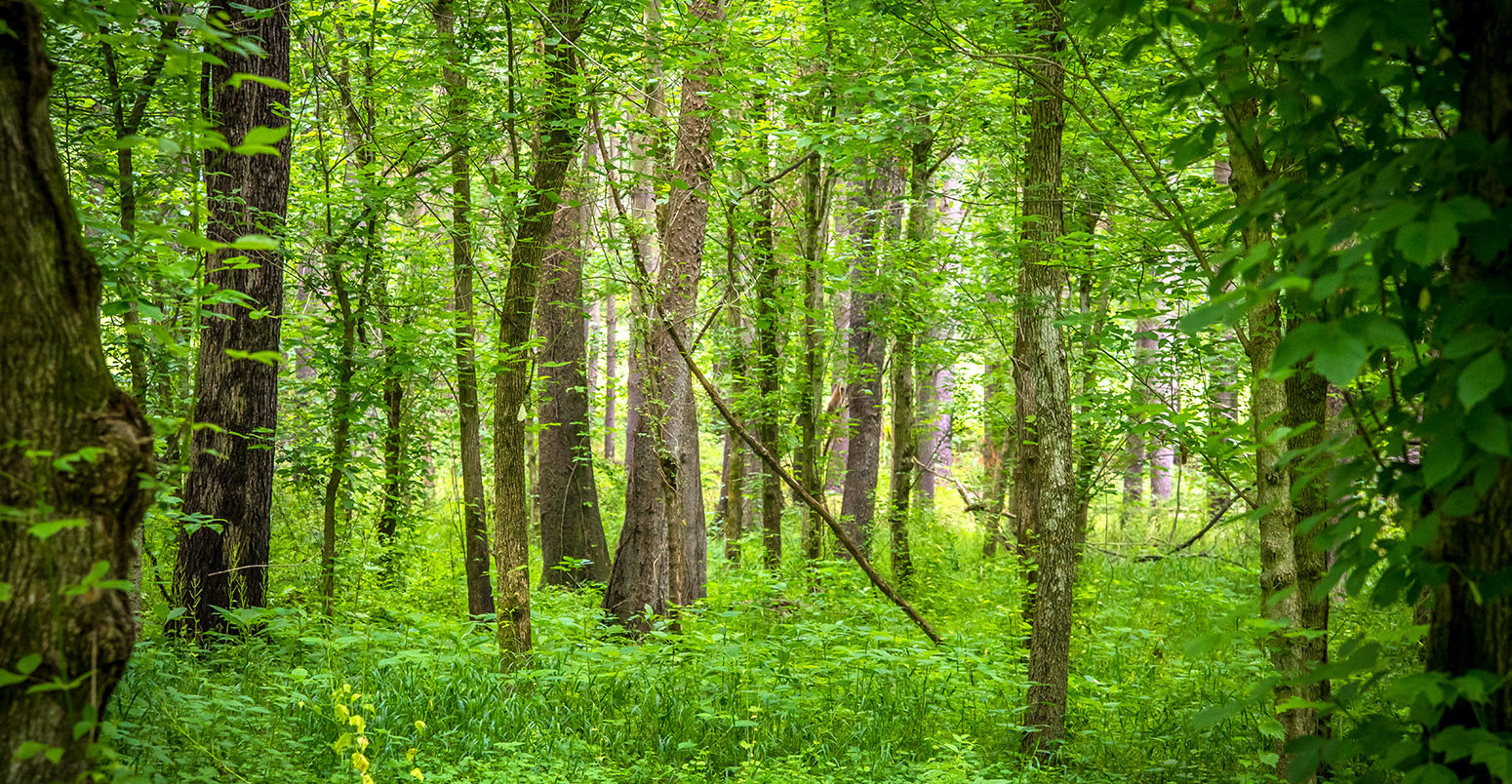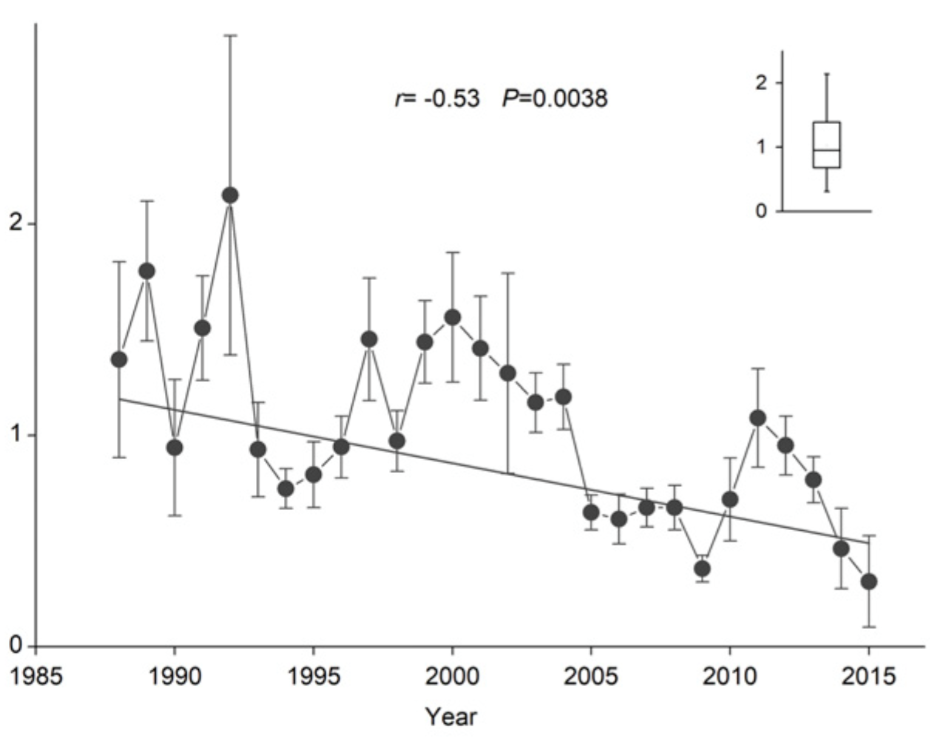
Methane uptake from forest soils has ‘fallen by 77% in three decades’
Daisy Dunne
08.06.18Daisy Dunne
06.08.2018 | 8:00pmThe amount of methane absorbed by forest soils has fallen by an average of 77% in the northern hemisphere over the past 27 years, a new study finds.
The research, which analysed soil data taken from more than 300 studies, suggests that the world is currently “overestimating the role that forest soils play in trapping gas”, the lead author tells Carbon Brief.
This reduced uptake of methane by soils is likely being driven by increases in soil moisture as a result of enhanced rainfall, the author adds. In wetter soils, the bacteria that break down and store methane are less able to function, he explains.
The discovery “means that methane will accumulate much faster in the atmosphere”, another scientist tells Carbon Brief.
Methane matters
Methane is a greenhouse gas that is 34 times more potent than CO2 over a 100-year period – meaning it has a powerful short term effect on the Earth’s climate – and the second largest contributor to human-caused global warming.
The largest source of human-caused methane emissions is agriculture – particularly from livestock and rice production. The second main driver is fossil fuel production – which allows underground methane to “escape” into the atmosphere during the drilling, extraction and transportation process.
On top of this, methane is also released by several natural processes, including from the activities of wetlands, melting permafrost and freshwater lakes.
However, the release of methane is largely offset by other natural processes which absorb methane from the atmosphere.
The troposphere – the lowest level of the atmosphere – is the largest sink for methane. In this part of the atmosphere, methane reacts with naturally occurring compounds known as “hydroxyl radicals” to form water and, to a lesser extent, CO2.
Down on the ground, soils – particularly forest soils – play a smaller, but still significant role in absorbing methane. These soils are home to specialised bacteria known as “methanotrophs” – literally meaning “methane eaters”. The bacteria absorb atmospheric methane that has diffused into the soil and break it down into smaller compounds that they can use as energy.
However, the activity of these microorganisms appears to have slowed “dramatically” in the past three decades, says Dr Peter Groffman, a microbial biologist and co-author of the research published in the Proceedings of the National Academy of Scientists. He tells Carbon Brief:
“Our analysis of methane uptake around the globe shows that methane uptake in forest soils has decreased by an average of 77% from 1988 to 2015. We conclude that the soil methane sink may be declining and overestimated in several regions across the globe.”
Determining the decline
For the study, the researchers monitored levels of soil methane uptake in two areas in the US – around the forests of Baltimore, Maryland and Hubbard Brook, New Hampshire.
In Baltimore, the scientists took samples from eight plots – in both urban and rural forests – every month from 1998-2016. In Hubbard Brook, samples were taken from eight plots in the summer months from 2002-2015.
The results showed that, in Baltimore, methane uptake decreased by 62% in urban forest soils and 53% in rural forest soils over the 18-year study period. At Hubbard Brook, methane uptake decreased by 74-89% across the plots over the 14-year period.
Motivated by these results, the researchers then carried out an analysis of more than 300 research papers containing data on forest soil methane uptake from across the world between 1988 and 2015.
The graph below shows the observed decline in methane uptake (per metre, per day) across the world from 1988-2015. The inset shows the average methane uptake during the time period.

Global decline in methane uptake in mg per metre per day from 1988-2015, according to an analysis of 317 published articles. The inset shows the average methane uptake during the time period. Source: Ni & Groffman (2018)
The researchers found that, in the northern hemisphere from the equator up to a latitude of 60 degrees North, soil methane uptake declined by an average of 77% over the time period.
Saturated soils
To determine the cause of the reduction in soil methane uptake at the two study sites, the researchers looked at a range of factors that are known to impact the activity of the methane-eating bacteria.
They found that uptake had decreased despite recent increases in air temperature at both sites – which is thought to boost bacteria activity.
The researchers also found that, in both regions, rainfall has increased over the past three decades – likely as a result of climate change – which has caused soil moisture levels to increase.
As soil moisture increases, less methane is able to diffuse into the soil from the atmosphere, Groffman explains:
“Increased soil moisture inhibits diffusion of methane from the atmosphere into the soil, which reduces the ability of bacteria to access and consume the methane.”
The researchers found that, across the northern hemisphere, areas that have seen a decrease in soil methane uptake have also tended to experience local increases in rainfall. (Carbon Brief has previously published a detailed explainer on how climate change could impact future rainfall across the world.)
The findings show “clear evidence” that the size of the soil methane sink is decreasing as a result of increased rainfall, says Dr Patrick Megonigal, director for research at the Smithsonian Environmental Research Center, who was not involved in the study. He tells Carbon Brief:
“The discovery that soils are consuming less methane over time is important because it means that methane will accumulate much faster in the atmosphere – all things being equal.
“The fact that the same patterns appeared in the global dataset is particularly impressive because it confirms the assertion that methane consumption by soils has declined dramatically; a more subtle decrease in rates would have been obscured by variations in study designs, locations and methods.”
Beleaguering budget
The findings suggest that the “global methane budget” – the balance of emissions and uptake of methane across the Earth’s surface – will need to account for a decrease in soil methane uptake, Groffman says:
“These findings suggest that global budgets for atmospheric methane – which are used to inform policy around methane-producing activities – are overestimating the role that forest soils play in trapping gas. Declining methane uptake by forest soils should be factored into these models to avoid exacerbating climate warming, as methane in the atmosphere may rise more quickly and reach higher levels than current models predict.”
The research should also serve as a reminder that relying on natural processes to soak up excess methane is a risky strategy, he adds:
“We can’t rely on natural processes to solve our greenhouse gas problems. Just as trees and oceans may not always be able to absorb CO2, forest soils may not always be able to take up methane and keep it out of the atmosphere.
“If we are going to stabilise the atmospheric concentration of methane, we are going to have to work harder to control anthropogenic sources such as leaks from natural gas extraction.”
The findings provide “strong evidence globally” that the soil methane sink is decreasing, says Prof Mari Pihlatie, a researcher of plant and microbiology from the University of Helsinki, who was also not involved in the research.
However, it is important to note that the trend does not hold everywhere, she says. At her research site in Hyytiälä, Finland, (which is just outside of the latitude range set by the study), levels of soil methane uptake are increasing. She tells Carbon Brief:
“We have a trend in increasing methane uptake, which coincides with increasing soil temperatures. Soil moisture does not seem to be critical in our site – which is really dry and, hence, greater precipitation would not decrease the soil methane uptake.”
Ni, X. & Groffman, P. M. (2018) Declines in methane uptake in forest soils, Proceedings of the National Academy of Sciences, doi/10.1073/pnas.1807377115
Updated on 8 and 9 August to amend definition of the global methane budget and potency of methane.
-
Methane uptake from forest soils has ‘fallen by 77% in three decades’
-
Forest soils are absorbing ‘77% less methane’ than three decades ago

